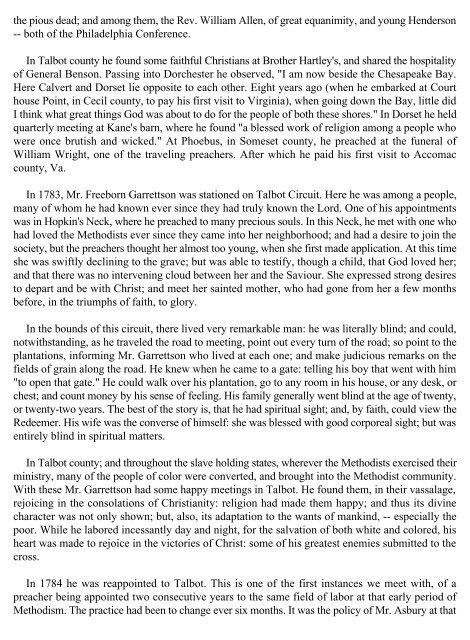A History Of The Rise Of Methodism In America - Media Sabda Org
A History Of The Rise Of Methodism In America - Media Sabda Org
A History Of The Rise Of Methodism In America - Media Sabda Org
You also want an ePaper? Increase the reach of your titles
YUMPU automatically turns print PDFs into web optimized ePapers that Google loves.
the pious dead; and among them, the Rev. William Allen, of great equanimity, and young Henderson<br />
-- both of the Philadelphia Conference.<br />
<strong>In</strong> Talbot county he found some faithful Christians at Brother Hartley's, and shared the hospitality<br />
of General Benson. Passing into Dorchester he observed, "I am now beside the Chesapeake Bay.<br />
Here Calvert and Dorset lie opposite to each other. Eight years ago (when he embarked at Court<br />
house Point, in Cecil county, to pay his first visit to Virginia), when going down the Bay, little did<br />
I think what great things God was about to do for the people of both these shores." <strong>In</strong> Dorset he held<br />
quarterly meeting at Kane's barn, where he found "a blessed work of religion among a people who<br />
were once brutish and wicked." At Phoebus, in Someset county, he preached at the funeral of<br />
William Wright, one of the traveling preachers. After which he paid his first visit to Accomac<br />
county, Va.<br />
<strong>In</strong> 1783, Mr. Freeborn Garrettson was stationed on Talbot Circuit. Here he was among a people,<br />
many of whom he had known ever since they had truly known the Lord. One of his appointments<br />
was in Hopkin's Neck, where he preached to many precious souls. <strong>In</strong> this Neck, he met with one who<br />
had loved the Methodists ever since they came into her neighborhood; and had a desire to join the<br />
society, but the preachers thought her almost too young, when she first made application. At this time<br />
she was swiftly declining to the grave; but was able to testify, though a child, that God loved her;<br />
and that there was no intervening cloud between her and the Saviour. She expressed strong desires<br />
to depart and be with Christ; and meet her sainted mother, who had gone from her a few months<br />
before, in the triumphs of faith, to glory.<br />
<strong>In</strong> the bounds of this circuit, there lived very remarkable man: he was literally blind; and could,<br />
notwithstanding, as he traveled the road to meeting, point out every turn of the road; so point to the<br />
plantations, informing Mr. Garrettson who lived at each one; and make judicious remarks on the<br />
fields of grain along the road. He knew when he came to a gate: telling his boy that went with him<br />
"to open that gate." He could walk over his plantation, go to any room in his house, or any desk, or<br />
chest; and count money by his sense of feeling. His family generally went blind at the age of twenty,<br />
or twenty-two years. <strong>The</strong> best of the story is, that he had spiritual sight; and, by faith, could view the<br />
Redeemer. His wife was the converse of himself: she was blessed with good corporeal sight; but was<br />
entirely blind in spiritual matters.<br />
<strong>In</strong> Talbot county; and throughout the slave holding states, wherever the Methodists exercised their<br />
ministry, many of the people of color were converted, and brought into the Methodist community.<br />
With these Mr. Garrettson had some happy meetings in Talbot. He found them, in their vassalage,<br />
rejoicing in the consolations of Christianity: religion had made them happy; and thus its divine<br />
character was not only shown; but, also, its adaptation to the wants of mankind, -- especially the<br />
poor. While he labored incessantly day and night, for the salvation of both white and colored, his<br />
heart was made to rejoice in the victories of Christ: some of his greatest enemies submitted to the<br />
cross.<br />
<strong>In</strong> 1784 he was reappointed to Talbot. This is one of the first instances we meet with, of a<br />
preacher being appointed two consecutive years to the same field of labor at that early period of<br />
<strong>Methodism</strong>. <strong>The</strong> practice had been to change ever six months. It was the policy of Mr. Asbury at that
















